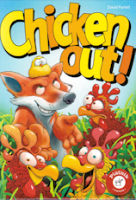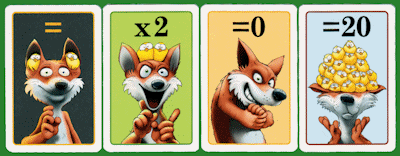
- Cards
- Fifty of the 60 cards are chicken cards numbered 0 to 11, each showing the appropriate number of chickens. The chicken numbers come in two colours, black and red. Black numbers must always be added; red ones may sometimes be subtracted. The other 10 are fox cards. Foxes are jokers and interfere with the chickens.
- Deal
- Shuffle the cards thoroughly and deal them all round, one at a time, till everyone has the same number. You each hold your cards face down in a pile without looking at their faces.
- Object
- In a single game, to be the first to play out all your cards. In a series of games, to win most cards by making 'runs' of 21 chickens.
- Play
- Dealer’s left-hand neighbour starts the first round by playing two cards from the top of their pile to start the chicken run and
announcing the total they make. For example, if they are 3 and 8, announce “Eleven”. You each in turn (passing to the left) play the top card of
your pile, add its value to the previous total, and announce the new count of chickens in the run. But:
- If it’s a red number that would bring the total to over 21 you subtract it instead of adding. (But you must add it if you safely can.)
- If it’s a fox, do as it says:
 "=" means this counts the same value and colour as the previous card, if any, otherwise zero
"=" means this counts the same value and colour as the previous card, if any, otherwise zero
"x2" means double the count
"=0" means set the count back to zero
"=20" means raise the count to 20"
Bust. If you bring the count to over 21 you must pick up all the cards just played, place them at the bottom of your pile and end your turn. The next in turn to play starts a new count by playing two cards from the top of their pile. (Not just one, even if it’s a “Fox = 20” card.)Twenty-one. If you make exactly 21 you pick up all the cards involved and set them aside as won cards. You then yourself start a new series yourself by playing from your hand, one by one, as many cards as you like until you either stop, bust, or make 21.Chicken out. If the count is 11 or more and you fear busting, you may 'chicken out' by picking up the cards so far played and placing them at the bottom of your pile. You then play two cards from your hand cards to start a new run. - Going out
- As soon as one player goes out the others keep playing till the current round of cards is taken. The player who went out wins. If more than two play, second and other positions depend on how many cards player have remaining in hand - the fewer, the better.
- Scoring
- As a two-player game we record the number of cards won at the end of each game and play as many games as necessary for one player to reach a total of 100.
- Optional extras (ignore them if you like)
-
- Every time you lay an egg (= play a zero) you must shuffle your cards before continuing. (This helps to randomise the gene pool.)
- If you play exactly the same numeral as the immediately preceding card, and don’t bust or make 21, you may play another card. (A 'Same' fox doesn't count as such, unless it follows another 'Same' fox”.)
- With more than four players the game may play too fast. To slow it down, when you make exactly 21 you don’t throw the cards out but pass them to your left-hand neighbour, who must add them to their hand.
- For your information
- There are four black and four red 7s, and two of each colour of other numerals 3 to 11. There are three each of 0 and 1, but black only - no reds. (Why would you want to subtract either number?) Four of the fox cards are "same as preceding card" and there are two each of the others.
Copyright

